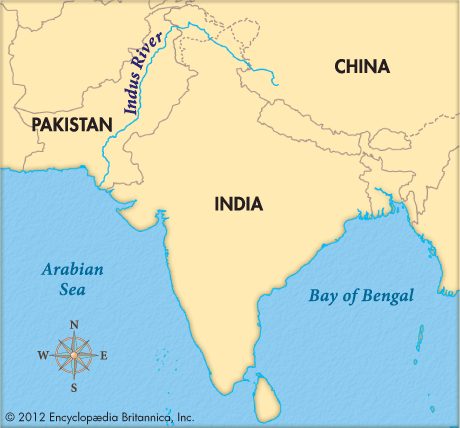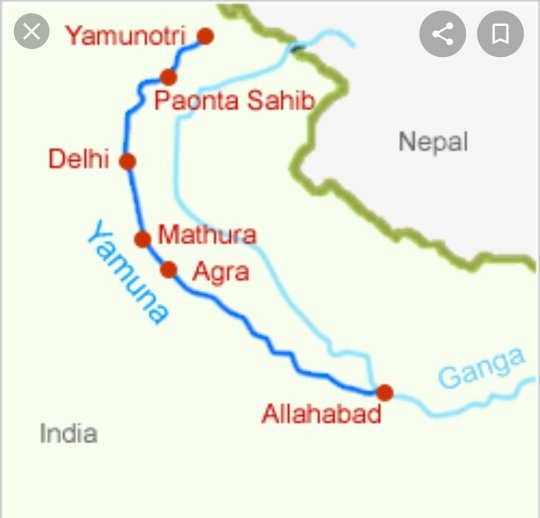
| VARSHGIR
Ravi River and 5 Rivers
River Sindhu (Indus)
River Yamuna and Ganga The first use of iron weapons in the world and the world's first war described in books.
In 3400 BC, on the northern part of India, the site of the five rivers which were spoken was the kingdom of a king named "Sudas" - it was called Tritsu kingdom. Rich in fertile land, rivers, mountains and milch animals, this area was called India's most prosperous area - this region is today's Punjab. All kingdoms were jealous of Tritsue kingdom. King Anu, the half-brother of King Sudas's wife, got together with other kings of India and abroad to form an army a very furious war took place on the banks of the Ravi river A detailed description of this great battle fought is available in the book 7, Verse 18 - 33, Chapters 83.4 - 8 of the Rigved. This war is called "Dasarajna Mahayudha" (war of 10 kings).
In this great war, King "Sudas" defeated 66000 infantry, 20 chariots, 2000 cavalry and 50 elephants led by King Anu of 10 kings with just 6500 soldiers in just one day. The whole army of 6 kings was killed along with King Anu in the battle. After giving the remaining 4 pardon, King Somak gave them permission to settle 200 Kos (640 kms) away from Sindhu (Indus). In this war, King Sudas's Guru gave him use arrows, spears and swords made of Iron instead of traditional wood and stones weapons, so that the enemy army could not understand what this weapon was, which was so small but yet so deadly and many soldiers were killed in one war. The army was horrifically killed. In this war, King Anu was also helped from abroad (today's Iran, Syria, Afghanistan, Turkey, Greece and Unan). In this war, King Somak with the help of his skill in just one day had finished the war. A mere purpose of this war was mass murder of Tritsu Kingdom, rob the wealth and kill citizens and family of King Sudas. After looting the wealth, King Anu would rule this area and it was decided to give equal share to everyone on annual wealth every year. But in this war, King Sudas defeated this mass huge army and laid the foundation of Akhand Bharatvarsh and Sudas Became the first emperor. Those who survived the war were displaced abroad and citizens admired kind Sudas for his strategy of war, politics and got respect of his citizens.
After this war, King Sudas laid the foundation of the world's first "Smart City - Harappa" and ruled this prosperous state for many years.
To win this war, Vashisth Muni had prepared a strategy for King Sudas. King Sudas was a descendant of Ikshvaku and these Muni Vashisth was a descendant of Maharshi Vashishth.
King Sudas defeated a combined army of ten kings in the Dashraj war on the banks of river Ravi and shortly thereafter, Sudas had to battle with three kings along the banks of the Yamuna. Sudas was victorious again in this war. Sudas had the fighting skills that he would let his enemy do every attack first. Sudas had learned from his Guru to let the enemy attack first and then run in different directions in different groups. If the enemy attacks, run according to the need and run away, splitting them into different troops. The enemy will also run backwards, bring the enemy to such a place that he will be surrounded by your troops. When the enemy has done all his tricks, then move on and kill the enemy.
After a battle with three kings on the banks of the Yamuna, Sudas also occupied the territory of the Doab of the Panchal, the banks of the Ganges and the Saraswati River in the north of the border of his kingdom. Instead of going further, Sudas was told by his Guru to go back and establish himself towards the West. As Sudas initially moved Eastward from the Five Rivers State (now Punjab) and then went back to West, the supporters of Macaulay called crossing of Sudus's Sindhu (Indus) river and moving Eastward to the Aryan Invasion Theory. On the contrary, those known as Arya crossed the Sindhu (Indus) from the region of Punjab and went from East to West. Those who lost or King Sudas's journey back to West from Saraswati river was in fact the first crossing of Sapta-Sindhu from India and the clan (kabele) was formed in Central Asia. Now crossing the Sindhu (Indus) from the West to the East was linked to the principle of Aryan Invasion. Whereas if the principle of Aryan Invasion was to be believed, the attack was to cross from West to East i.e. Sapta-Sindhu from West to East - while exactly the opposite happened i.e. crossing from East to West.
On the other hand, after the Dasharajna war, the people of the defeated kings went towards the west and there is evidence that these people laid the foundation of the five major kingdoms Parthi, Persians, Baloch, Pakhtun and Pishk (Kurd). Apart from these, the people who lost in this war and other people divided into 16 groups and went to different places. These people found evidence of 16 other areas which they have found in Sogdiana, Margiana, Bactra, Kabulistan, Ghazni, Nanta, Archosia, Drangiana, Zamin - These clans (kabele) were established in the area between Dawar and Kalat-e-Giljay, the Lugar valley, the area between Kabul and Kurram, at Aryanya, Vaizeh, Iran, etc.
After
King Sudas, his grandson King Somak also had to fight a war with
those people because those people settled in the clan (kabele) after
crossing the Indus wanted to come back and establish their dominion
to the prosperous region by crossing Sapta-Sindhu. Some tribes together
again attacked the area of Sapta Sindhu, which was defeated by Sudas's
grandson King Somak in their own area. This battle was fought in
the area which is today's Afghanistan. It is called "War of
the Varshagir" - "The Varshagira Battle".
The foundation of Bharatvarsh was laid after the victory of Sudas. Probably after the Sapta Sindhu and Aryavart conquests, Sudas again moved towards East, so that the territory of Saryu was also included in his kingdom or the kings here accepted the sovereignty of Sudas. Sudas often faced challenges along the West border. The losers who laid the foundations of the five states and sixteen tribes often tried to re-establish and settle on areas beyond the Sindhu (Indus). Their efforts were war rather than compromise or peace and they could not stand before the power and battle skills of Sudas, due to which Sudas's whole life was spent fighting. Due to the war, the Western powers were ending, while the collective area of Sapta-Sindhu and Aryavart became stronger due to rivers, mountains, fertile land, milch animals, etc.
Since
there was a shortage of water, crops and milch animals in the western
regions, for many years these displaced groups spent more time establishing
themselves in proper place. These people more and more settled in
today's Iran, Kurds of Iraq, Afghanistan, Greece and some other
places. It took them years to organize everything in these places.
Meanwhile, there is no description of any major war. The third generation
of King Sudas was "Raja Somak".
Raja
Sahadev and Raja Rajashvar supported King Somak. The combined soldiers
of these three crossed the Sindhu (Indus) and marched towards Afghanistan.
As Rajan of Gandhar clan (today's Peshawar) called Raja Somak for
help, Somak's military force found a way to move forward comfortably.
At that time Swat Ghati, Patohar Pathar, Khyber Pakhtunkhwa and
Jalalabad used to come under Gandhar.
This informative historical material is of Mr. Ranjay Tripathi. |


